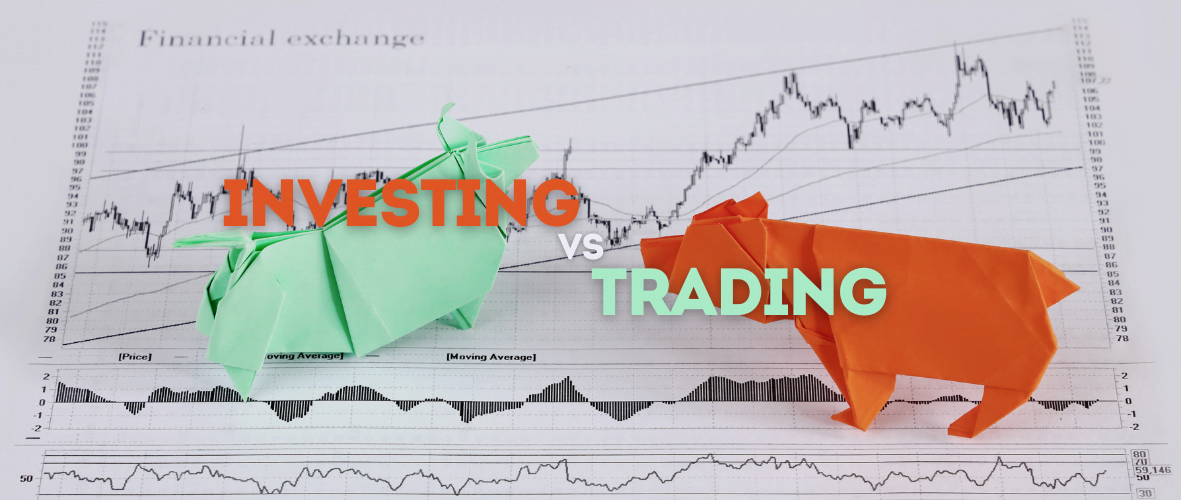Trading vs Investing: How Are They Different?

The phrases "trading" and "investing" are frequently used together in the financial industry. They do, however, reflect different approaches to building wealth over time with significant functional differences. Understanding the fundamental differences between these strategies is essential for anybody managing markets of any size.
The following article seeks to give a thorough introduction to trading and investing by digging deeply into some of its most important characteristics. The topics that will be examined include defining qualities, time spans, trade-offs between risk and reward, various approaches and methods, necessary tools and resources, and important psychological elements that affect results.
By thoroughly examining both in a balanced manner, readers will have a deep understanding of their fundamental distinctions, appropriate situations, and which might best meet individual goals in light of financial circumstances, risk tolerance, free time, and desires. In the end, having a solid awareness of these little differences gives everyone control over their financial destiny.
Fundamental Concepts of Trading And Investing
Fundamentally, investing implies a longer-term capital commitment, whereas trading indicates speculative activity over the short term. Trading is the process of quickly purchasing and then selling a variety of assets to profit from price fluctuations, which can occur within hours or even seconds, regardless of the subject matter. In this arena, technical analysis that emphasizes turnover and continual motion prevails over fundamentals.
Investing, on the other hand, refers to allocating resources to projects in the hopes of earning dividends, interest, or capital gains that will compound over years, ideally decades. Owners closely examine issuers, never stopping to reevaluate conviction instead of merely pursuing momentum. Purchasing fairly priced, high-quality assets to hold for the long term is emphasized.
While sharing common goals like wealth creation, these stratified archetypes denote antithetical strategic mindsets requiring uniquely compatible temperaments, risk tolerances, and lifestyle alignments for those pursuing flourishing within each sphere successfully by their distinct natures.
Timeframes in Depth
The single biggest difference between trading and investing may be the duration over which objectives are achieved. For traders, opportunities come and go quickly, requiring fast response times and continuous attention to a steady flow of information. Typically, positions open and close within day, week, or month intervals.
By contrast, investors adopt long-term views that enable compound interest and gains to grow exponentially from long-term investments. Over time, volatility lessens because solid funds and firms eventually overcome cyclical difficulties. The short-term turmoil has little bearing in this context.
This gap between demands that span decades and microseconds profoundly influences the dynamics of decision-making, risk management, emotional resilience requirements, and overall lifestyle appropriateness for any endeavor. While long-term investments encourage patience and distance, trading demands constant attention.
Risk and Reward Profiles
The risk-reward profiles differ significantly as timescales do. Day trading exposes funds to increased short-term risk since trades can happen quickly, resulting in both gains and losses. Excessive percentage profits are possible, but without strict supervision, uncontrolled risk turns disastrous.
On the other hand, a multiyear investment significantly lessens the impact of volatility over time. Good choices eventually make up lost ground because fundamentals hold up during recessions. Supplements with compounding yield exponential returns, barely compensating for any short-term negative effects. In the end, rewards massively validate patience.
All markets have swings, but over time, well-rounded portfolios chosen carefully from reputable managers have traditionally recovered lost territory and then some. As a result, risk management becomes easier due to diversification and horizon expansion, which also reduces stress levels appropriately. Results are less dependent on having exact time.
Trader Strategies and Techniques

Technical indicators and patterns are used by traders to detect brief market deviations from intrinsic values, which indicate favorable times to enter and exit the market. While swing trading lasts two to four weeks and uses momentum shifts, ideally utilizing intraday volatility, day trading closes all of its positions at the end of each trading session.
While news traders earn from reactions to unexpected economic reports and business events that may cause short-term market volatility, scalpers profit from small intraday movements. Algorithmic traders automate techniques that methodically eliminate emotion from snap judgments. Every specialized specialization necessitates developed competency via training and experience.
Traders can use proprietary platforms' real-time streaming quotations and insider-level capabilities to graphically simulate transactions before committing to anything. Strong risk management protects capital by sizing positions based on volatility and implementing automated stops. Parameters are traditionally optimized via backtesting novel concepts.
Investment Strategies & Techniques
In contrast, investors select holdings aligned with their goals, risk profiles, and beliefs growing portfolios organically through continual reassessment. Sustainable strategies include value investing carefully selecting underpriced stocks primed for reversion and growth options anticipated flourishing for many years ahead.
Whereas market-replicating ETFs passively track indicators while reducing costs, income strategies focus on equities, bonds, REITs, and closed-end funds that offer substantial dividends. Investors who practice social responsibility back causes that share their values. Commodities and real estate are common examples of actual assets that are included in comprehensive, risk-reduced programs.
Investment choices are made based on a basic study that considers industry and sector trends, debt levels, margins, returns on equity, management experience and integrity, and competitive advantages. Over time, diversification reduces volatility by distributing money sensibly among different asset classes, sizes, styles, and geographic areas. Through fluctuations, rebalancing maintains discipline.
Tools and Resources Comparison
Despite being very different, technology is quite important in both fields. To optimize efficiency and profits per transaction, traders utilize fast direct-access systems that include powerful charting, scanning, algorithmic capabilities, and automatic order routing. Economic calendars provide advance notice of news that might quickly move markets.
Investors thoroughly examine and carefully analyze risk-adjusted predicted returns of proposals by consulting SEC 10-K/Q filings, third-party research, discounted cash flow models, discounted dividend models, and Monte Carlo simulators. By linking users globally and allowing them to openly exchange due diligence, social networking broadens viewpoints.
Educational resources from banks, brokerages, and online constantly increase understanding of concepts and applications. AI-driven robo-advisors that reduce costs through automatic rebalancing and tax loss harvesting are examples of new technologies that are emerging. Investors use technology advancements to their advantage, enhancing long-term performance, while traders wisely use cutting-edge platforms to close information gaps rather than focusing on quick speeds.
Psychological Considerations
Psychology is the most important aspect influencing results in finance in general and each of these areas in particular. In a turbulent market where prices fluctuate dramatically, traders need to cultivate an unwavering emotional discipline that controls their greed and fear, which can lead to distorted split-second decisions.
Burnout risks are significant, requiring frequent breaks and incorporating social and mental health into everyday routines to avoid exhaustion and mounting stress that exceeds the required sharpness. On the other hand, investors need to exercise determined fortitude to maintain their convictions during economic cycles, eventually putting their patience to the test, controlling their behavioral biases, and inflating their expectations of returns.
Conclusion
In summary, even though both trading and investing aim to increase capital, they represent different ideologies through set goals, risk control, analytical methods, and psychological requirements for achievement. Designing personalized strategies that take into account each person's unique capabilities and suit their risk tolerance, availability, inherent characteristics, and stage of life is only possible by deeply understanding differences. The most reliable way to empower financial responsibility based on individual circumstances and visions is still through continuous learning.